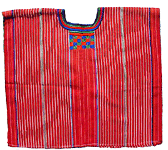| . |
 |
|
|
|
| By Lee Ann Ward | |
| . | |
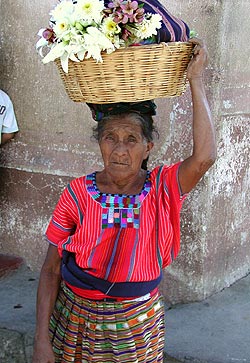 |
|
| . | |
|
LINKS TO SECTION PAGES |
|
| . | |
| CLICK ON IMAGE FOR LARGER SIZE |
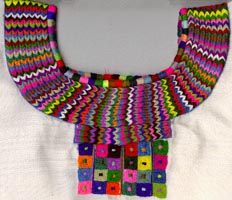 |
| . | |
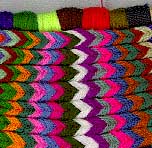 The
huipil of San Juan La Laguna was originally a white backstrap woven
cotton cloth with an embroidered neckline that
included small squares of varied colors in a pattern of four rows of six,
centered on the front and back of the garment. The square symbolizes the
Mayan number one. When German dyes were later introduced to Guatemalan
textiles, the white cloth was replaced with a bright red striped cloth.
The traditional corte or skirt worn by San Juaneras was a simple
design of black cotton with a white stripe. The
huipil of San Juan La Laguna was originally a white backstrap woven
cotton cloth with an embroidered neckline that
included small squares of varied colors in a pattern of four rows of six,
centered on the front and back of the garment. The square symbolizes the
Mayan number one. When German dyes were later introduced to Guatemalan
textiles, the white cloth was replaced with a bright red striped cloth.
The traditional corte or skirt worn by San Juaneras was a simple
design of black cotton with a white stripe. |
|
| . | |
| . | 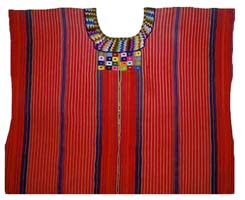 I first travelled to the Maya
Tzutujil village of San Juan La Laguna in May of 1987, at the invitation
of a young friend from the village, Florinda,
who was attending school in Antigua, Guatemala. As I spent more time in
San Juan, several of the women gave me lovely hand woven dresses and
cloth. Although most Tzutuhil women in the village learn to weave at a
young age, I soon realized that few weavers were able to earn a fair wage
for their work, because middle people purchased their weavings for little
more than the cost of the yard used in making the cloth. A group of
weavers and sewers asked for my assistance in organizing a production and
marketing association to produce and sell textiles for export. The group, Las
Artesanas de San Juan, sought fair markets in order to avoid continued
exploitation by middle people. They have attempted to provide a fair wage
to weavers and sewers, and over the years they have been a force for |
| . | |
| . | 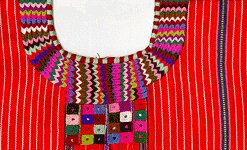 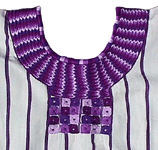 |
| . | The embroidered collar above left is typical of most modern huipiles from San Juan la Laguna while the right hand huipil is of unusual coloration. The huipil being woven of white fabric with purple stripes could be older. The white huipil at the top of the page certainly is the oldest of the three and has the finest quality embroidery. It was originally a child's huipil. A machine-made piece of white cloth has been added to each side of the original hand-woven huipil to enlarge it so it could be worn by a woman. |
| . | |
| . | 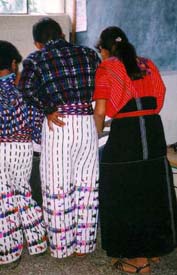 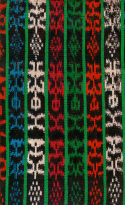 Left:
The modern man's shirt may have a figurative ikat design rather
than the traditional jaspe design. The man's shirt and pants are
indistinguishable from those of San Pedro la Laguna. The shirts of the
young boys are most often of a sky-blue jaspe. The boy on the left
in the photo at the right wears such a shirt. The boy in the
center of the photo has an ikat shirt similar to the design at
left. Left:
The modern man's shirt may have a figurative ikat design rather
than the traditional jaspe design. The man's shirt and pants are
indistinguishable from those of San Pedro la Laguna. The shirts of the
young boys are most often of a sky-blue jaspe. The boy on the left
in the photo at the right wears such a shirt. The boy in the
center of the photo has an ikat shirt similar to the design at
left. |
| . | |
| . | LINKS TO SECTION PAGES |
| . | |
|
|
To contact us write: Arte Maya Tz'utuhil, P.O. Box 40391, San
Francisco, CA 94140. Telephone: (415) 282-7654.
Email me at
All paintings and photographs Copyright © 1988–2015 Arte Maya Tz'utuhil |
